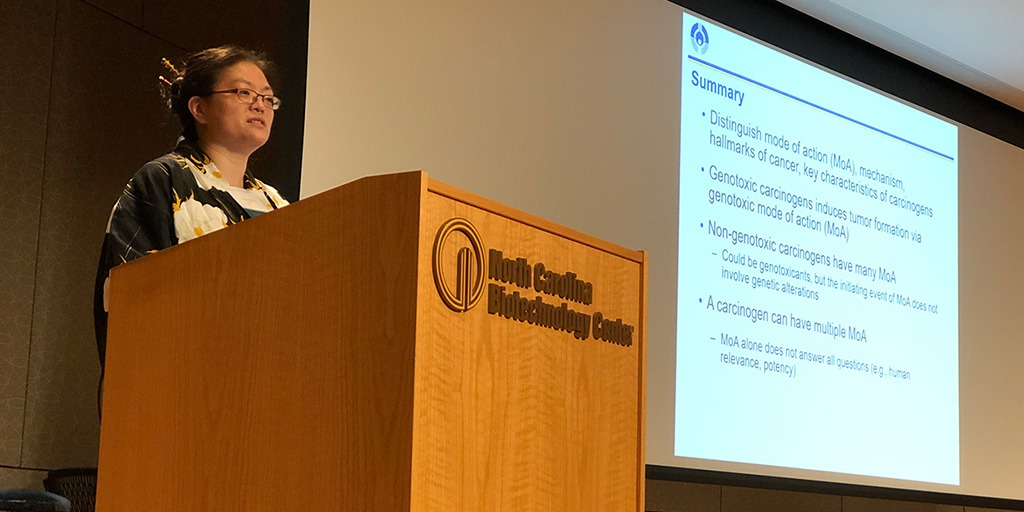Biological factors that can lead to cancer were the focus of the fall meeting of the Genetics and Environmental Mutagenesis Society (GEMS), held Oct. 30. Local scientists, trainees, and students met at the North Carolina Biotechnology Center in Durham.
Speakers discussed genotoxic and nongenotoxic mechanisms that may result in cancer. An agent is considered genotoxic if it damages or mutates DNA, but much discussion centered on nongenotoxic agents.
Meeting organizer Arun Pandiri, B.V.Sc. & A.H., Ph.D., a pathologist in the National Toxicology Program (NTP), focused the meeting on substances that activate various nuclear receptors, including estrogen receptor, constitutive androstane receptor, and peroxisome proliferator-activated receptor.
The conference also featured poster presentations and talks by area trainees. Scientists exchanged ideas about a variety of topics, such as cancer risk assessment.
What is a carcinogen?
Amy Wang, Ph.D., a health scientist in the NTP Office of the Report on Carcinogens, reviewed genotoxic and nongenotoxic origins of cancer. She then described the key characteristics of carcinogens (see sidebar).
Wang also discussed new interests among cancer researchers.
- Epigenetic changes — DNA modifications that affect gene expression but do not alter the genomic sequence.
- The microbiome — the collection of microbes living in and on humans.
She emphasized that recent progress in detection methods has allowed many more mutations to be identified. “With new technology, we are seeing a lot more than we saw before,” she said. “It is an exciting time to research carcinogenesis.”
Synthetic estrogen, cancer risk
NIEHS Scientist Emeritus Kenneth Korach, Ph.D., spoke about his research on hormone-induced cancers. He provided historical perspective on the institute’s pioneering research on diethylstilbestrol (DES), once prescribed for prevention of miscarriages and premature births.
DES, a synthetic estrogen, was linked to vaginal cancer in the early 1970s. NIEHS-funded research has helped to shed light on other potential negative health effects, such as attention deficit hyperactivity disorder, passed to offspring.
 Korach heads the Receptor Biology Group at NIEHS. (Photo courtesy of Jesse Saffron)
Korach heads the Receptor Biology Group at NIEHS. (Photo courtesy of Jesse Saffron)Korach said he appreciated the meeting’s focus. “When I go to hormonal cancer meetings, they’re [usually] talking about treatment of cancers … and not really about how these cancers develop — what’s the cause, and why it occurs in some tissues and not others.”
George Woodall, Ph.D., of the U.S. Environmental Protection Agency (EPA), capped off the day with an absorbing presentation on assessing cancer risk. He described challenges such as attempting to measure risks over time and accounting for exposures to multiple substances.
“Real-world exposures are rarely at continuous low levels. Exposures to chemicals, especially in occupational settings, are going to be all over the place,” Woodall noted.
Trainees take home awards
Elizabeth Martin, Ph.D., a postdoctoral fellow in the Eukaryotic Transcriptional Regulation Group, won a $1,500 travel grant for her talk on synthetic progestins. Those pharmaceutical compounds have been linked to increased susceptibility to invasive breast cancer.
 Martin’s presentation was titled “Synthetic Progestins and Progesterone Induce Similar Proliferative Transcriptomic Profiles in the T47D Breast Cancer Cell Line.” (Photo courtesy of Jesse Saffron)
Martin’s presentation was titled “Synthetic Progestins and Progesterone Induce Similar Proliferative Transcriptomic Profiles in the T47D Breast Cancer Cell Line.” (Photo courtesy of Jesse Saffron)The poster competition yielded three awards.
NIEHS is a long-time sponsor of GEMS, which was founded in 1982 and is headquartered in Research Triangle Park. The society’s next meeting is scheduled for May 12, 2020.
(Ernie Hood is a contract writer for the NIEHS Office of Communications and Public Liaison.)
Source link
factor.niehs.nih.gov


